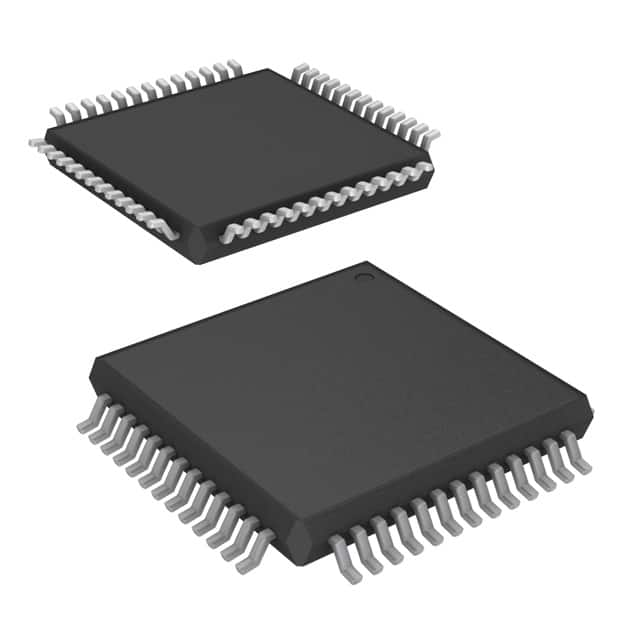Xem thông số kỹ thuật để biết chi tiết sản phẩm.

UPSD3212C-40T6
Product Overview
Category
The UPSD3212C-40T6 belongs to the category of microcontrollers.
Use
This microcontroller is commonly used in various electronic devices and systems for controlling and managing their operations.
Characteristics
- High-performance microcontroller with advanced features
- Low power consumption
- Compact size
- Wide operating voltage range
- Robust design for reliable performance
Package
The UPSD3212C-40T6 comes in a compact package, suitable for surface mount technology (SMT) assembly.
Essence
The essence of this microcontroller lies in its ability to provide efficient control and management capabilities for electronic devices and systems.
Packaging/Quantity
The UPSD3212C-40T6 is typically packaged in reels or trays, containing a specific quantity of microcontrollers per package. The exact quantity may vary depending on the supplier.
Specifications
- Microcontroller model: UPSD3212C-40T6
- Operating voltage range: 2.7V to 5.5V
- Clock frequency: Up to 40 MHz
- Flash memory: 32 KB
- RAM: 2 KB
- I/O pins: 32
- Communication interfaces: UART, SPI, I2C
- ADC channels: 8
- Timers/counters: 4
Detailed Pin Configuration
The UPSD3212C-40T6 microcontroller has a total of 44 pins. Here is a detailed pin configuration:
- VDD - Power supply voltage
- GND - Ground
- RESET - Reset input
- XTAL1 - Crystal oscillator input
- XTAL2 - Crystal oscillator output
- P0.0 to P0.7 - General-purpose I/O pins
- P1.0 to P1.7 - General-purpose I/O pins
- P2.0 to P2.7 - General-purpose I/O pins
- P3.0 to P3.7 - General-purpose I/O pins
- P4.0 to P4.7 - General-purpose I/O pins
- P5.0 to P5.7 - General-purpose I/O pins
- P6.0 to P6.7 - General-purpose I/O pins
- P7.0 to P7.7 - General-purpose I/O pins
- PSEN - Program store enable
- ALE - Address latch enable
- EA/VPP - External access/programming voltage
- AD0 to AD7 - Analog-to-digital converter inputs
- SDA - I2C data line
- SCL - I2C clock line
- TXD - UART transmit data
- RXD - UART receive data
- T0 - Timer 0 input
- T1 - Timer 1 input
- T2 - Timer 2 input
- T3 - Timer 3 input
- INT0 - External interrupt 0 input
- INT1 - External interrupt 1 input
- INT2 - External interrupt 2 input
- INT3 - External interrupt 3 input
- INT4 - External interrupt 4 input
- INT5 - External interrupt 5 input
- INT6 - External interrupt 6 input
- INT7 - External interrupt 7 input
- VBAT - Backup battery voltage input
- VREF - Reference voltage output
- AVSS - Analog ground
- AVDD - Analog power supply
- AGND - Analog ground
- AVCC - Analog power supply
- VDDIO - I/O power supply voltage
Functional Features
- High-speed processing capabilities
- Flexible I/O configurations
- Multiple communication interfaces for seamless integration with other devices
- On-chip memory for program storage and data handling
- Analog-to-digital converter for sensor interfacing
- Timers/counters for precise timing operations
- Interrupt capability for event-driven programming
- Low-power modes for energy efficiency
Advantages and Disadvantages
Advantages
- High-performance microcontroller suitable for demanding applications
- Wide operating voltage range allows compatibility with various power sources
- Compact size enables integration into space-constrained designs
- Robust design ensures reliable operation in harsh environments
Disadvantages
- Limited flash memory and RAM capacity may restrict the complexity of programs and data handling
- Lack of built-in peripherals may require additional external components for specific functionalities
Working Principles
The UPSD3212C-40T6 microcontroller operates based on the principles of digital logic and embedded systems. It executes instructions stored in its flash memory, interacts with external devices through its I/O pins
Liệt kê 10 câu hỏi và câu trả lời thường gặp liên quan đến ứng dụng UPSD3212C-40T6 trong giải pháp kỹ thuật
Sure! Here are 10 common questions and answers related to the application of UPSD3212C-40T6 in technical solutions:
Q: What is UPSD3212C-40T6? A: UPSD3212C-40T6 is a microcontroller unit (MCU) manufactured by NXP Semiconductors.
Q: What are the key features of UPSD3212C-40T6? A: The key features of UPSD3212C-40T6 include a 8051-compatible core, flash memory, SRAM, multiple I/O ports, timers, UART, SPI, and I2C interfaces.
Q: What is the operating voltage range for UPSD3212C-40T6? A: The operating voltage range for UPSD3212C-40T6 is typically between 2.7V and 5.5V.
Q: Can UPSD3212C-40T6 be used in battery-powered applications? A: Yes, UPSD3212C-40T6 can be used in battery-powered applications due to its low power consumption and wide operating voltage range.
Q: What programming languages can be used with UPSD3212C-40T6? A: UPSD3212C-40T6 can be programmed using assembly language or high-level languages like C or C++.
Q: Does UPSD3212C-40T6 have built-in communication interfaces? A: Yes, UPSD3212C-40T6 has built-in UART, SPI, and I2C interfaces, making it suitable for various communication protocols.
Q: Can UPSD3212C-40T6 be used in industrial automation applications? A: Yes, UPSD3212C-40T6 is commonly used in industrial automation due to its robustness, reliability, and support for various communication protocols.
Q: What is the maximum clock frequency of UPSD3212C-40T6? A: The maximum clock frequency of UPSD3212C-40T6 is 40 MHz.
Q: Can UPSD3212C-40T6 be used in automotive applications? A: Yes, UPSD3212C-40T6 can be used in automotive applications as it meets the required temperature and voltage specifications.
Q: Are development tools available for programming UPSD3212C-40T6? A: Yes, NXP provides development tools like IDEs, compilers, debuggers, and evaluation boards specifically designed for programming and testing UPSD3212C-40T6.
Please note that the answers provided here are general and may vary depending on specific requirements and use cases.

